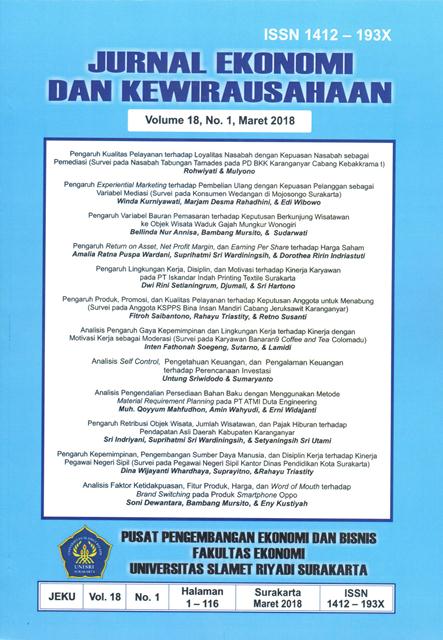ANALISIS PENGENDALIAN PERSEDIAAN BAHAN BAKU DENGAN MENGGUNAKAN METODE MATERIAL REQUIREMENT PLANNING PADA PT ATMI DUTA ENGINEERING
Abstract
The purpose of this research is to analyze the raw material needs planning policyimplemented by ATMI PT Duta Engineering. Analyzing the application of the method of
Material Requirements Planning can play a role in optimizing raw material inventory
control at PT Duta ATMI Engineering. Analytical techniques used in this research is by
using the method of MRP (Material Requirements Planning). The research results
obtained conclusions planning needs raw materials policy implemented by ATMI PT
Duta Engineering yet structured, it is apparent from the raw material procurement
system which uses a method of forecasting in accordance with sales targets. Application
of the method of Material Requirements Planning can play a role in mengoptimumkan
raw material inventory control at PT Duta ATMI Engineering, it is shown in the total
cost of the inventory using the technique of Lot For Lot (LFL) is Rp 15,443,120, the total
cost of the inventory using the technique of Fixed Order Quantity amounting to Rp
13,277,760 and the total cost of the inventory using the policy of the company amounting
to Rp 50,754,720. From the comparison it can be noted that a very effective technique to
achieve cost-efficiency the total inventory of raw materials is the technique of Fixed
Order Quantity.
Keywords: need raw materials, Material Requirements Planning.
Downloads
Published
2018-11-27
Issue
Section
Artikel
License
Authors who publish this journal agree to the following terms:
- Authors retain copyright and grant the journal right of first publication with the work simultaneously licensed under a Creative Commons Attribution License that allows others to share the work with an acknowledgement of the work's authorship and initial publication in this journal.
- Authors can separately make additional contractual arrangements for non-exclusive distribution published by the journal (e.g., publish it in a book), with an acknowledgement of its initial publication in this journal.
- Authors are allowed and encouraged to send their work via online (e.g., in the institutional repositories or their website) after published by the journal.









